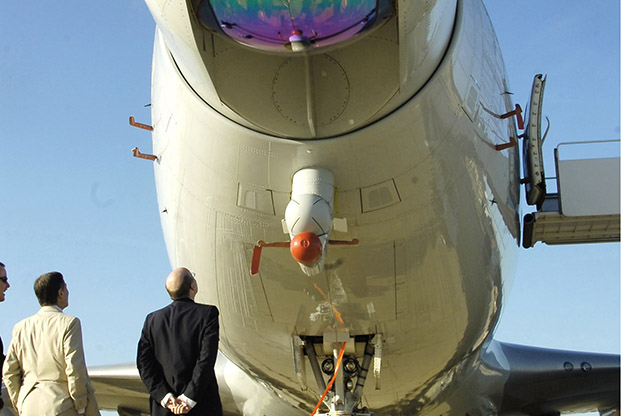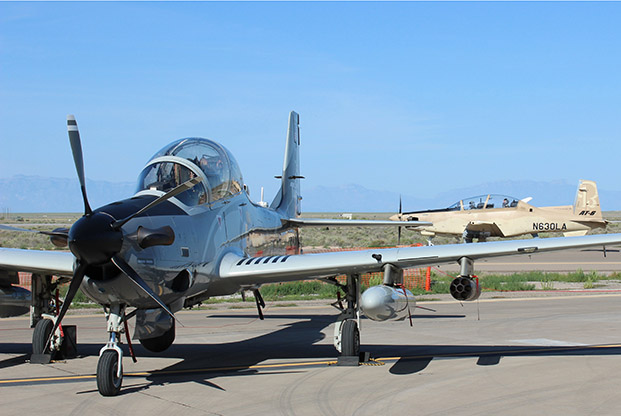
The Airborne Laser prototype at Andrews AFB, Md., in 2007. Photo: USAF
The Pentagon and industry agree that a faster tempo of military prototyping and experimentation is key to getting ahead—and staying ahead—of China, Russia, and other world competitors. The Air Force is on board, but it’ll take time and dedicated effort to shake off the risk aversion that has settled on the service in recent years.
In an interview with Air Force Magazine, Gen. Ellen M. Pawlikowski, head of Air Force Materiel Command (and slated to retire after 40 year’s of commissioned service) expressed confidence that USAF will get there—that there are world-leading achievements ahead in hypersonics, directed energy, biology, materials science and artificial intelligence, to name a few—but overcoming the fear of failure won’t be a trivial task.
“We are where we are in acquisition because this is what we asked for,” Pawlikowski said. “And we woke up and realized it was taking too long to get technology out there.”
The culprit was a push in the last decade to closely tie research dollars to a predictable outcome or to answer a stated operational requirement; an approach that makes it easier to justify budgets but discourages the risk-taking necessary to achieve scientific breakthroughs.
“Especially after sequestration, we have [a] structure—even outside the acquisition community—that has driven us to scrutinizing every single dollar we spend and trying to justify that we absolutely have to spend it,” Pawlikowski said.
She continued that USAF has “an appetite to … put money into these experiments” without a certainty that “you’re really going to get anything out of it.”
The services are being given new authorities to try new approaches. However, “We can put all kinds of rules in place that will allow program managers to go fast and allow us to team up with the operators” on quick solutions to operational problems, “but our budgeting and programming system has not adjusted to that.” Until it does, the Air Force will struggle to accelerate its technological advance, she said.
Pawlikowski considers the OA-X or “Light Attack Experiment”—evaluating small armed turboprops to substitute for high-end combat jets in uncontested airspace—a success so far, but even with this high-profile venture, the money couldn’t keep up with the pace of the project.
“First of all, there’s the automatic two-year lag” between getting a “great idea” and creating a budget line for it, much less a “program of record,” Pawlikowski observed.
With the OA-X, “we were able to demonstrate we could use … other transaction authorities,” she said. “I’m very proud of my test team, on how they were able to run fast but still put together a structured test program that enabled us to collect data to help us make a decision.” That, she said, is “the key to an experiment, right? It’s not a demo, it’s not a stunt.” The project was created in order “to learn from it.”
Hampering the project is the fact that the requirements community can’t really make up its mind whether it actually wants the Light Attack asset, Pawlikowski said.
It’s still struggling with, “how much ‘off the shelf’ am I willing to accept?” she noted. Ultimately, money was put into the Fiscal 2019 budget request to pursue OA-X.
Speed is going to require batting down the fear USAF will “spend money that we get nothing for.” Also, because of the two-year budget lag, “we’re going to need to have flexibility to move dollars around in the year of execution,” she warned. If OA-X needs more money than planned, “I can’t really influence that until I do an omnibus [reprogramming of funds] next spring, right?”
Speeding development requires “buy-in across the spectrum, to include the Congress, all the way through the Department of Defense, the Air Staff” and financial managers. The need is to “have the flexibility within the dollars in a year to be able to make a decision and then in six months be on contract,” she said. “Because if you don’t, then no matter how fast I make the acquisition process, if there’s no money to spend, we’re not going to go fast.”
LESSONS OF ABL
Is there a risk in “trying to do something too fast, too soon? Oh yes,” Pawlikowski said, holding out the Airborne Laser (ABL) program, which she led for nearly five years, as the “poster child for that.”
For Pawlikowski, who holds advanced degrees in chemistry and has extensive program management experience, ABL was seemingly a perfect project to direct. An enormous flying chemistry set, ABL was a 747 crammed with the plumbing needed to feed the enormous chemical-oxygen iodine laser (COIL).
The idea was to shoot the laser at a ballistic missile in its boost phase from over 100 miles away, rupturing its casing so the missile would explode and fall back down on the country that launched it. The prime threat it was meant to counter was North Korea.
When she took the program over she was told “all that was left was the engineering of it.” ABL proved far more complex than that, and Pawlikowski agreed with the program’s termination, on the grounds that it was too expensive and cumbersome, even though it worked. “It needed another cycle of tech maturity and engineering, and nobody had the stomach to put another $3 to $4 billion into another single airplane,” she observed.
Breakthroughs can’t be planned, she said. The only way to mitigate the risk, on any brand-new technology venture, “is not to make it resource-constrained, and not to have … set an expectation that at a given point, you’re going to have something” operationally useful.
USAF is also going to have to get comfortable with accelerated systems not having a fully developed logistics tail behind them, because developing those support systems takes time.
“More rapid fielding means we’re going to have to accept that things are not going to be perfect, and we’re going to have less of a stable baseline,” she noted.
Pawlikowski thinks the future may be marked by buying new systems in small numbers and discarding them when they get hard to support, much as a cell phone user typically buys a new phone instead of trying to sustain one that’s 15 years old.
With regard to the light attack aircraft, ideally she’d buy 20 a year, “and when they reach the point where the parts … aren’t available anymore,” she’d either retire them to the boneyard or sell them to an interested ally and “buy a new one.” Increasingly, the effort to support aging airframes is “penny-wise, pound-foolish.”
The future Air Force may also not align its program offices under platforms like “fighters” or “bombers” but “align under a mission; … a capability [rather than] under an individual platform, she predicted. “And when we do that … those things that we put on those platforms I believe will be closer to ‘throwaway,’?” she forecast. Keeping hardware in the system for decades “is killing us” in cost and manpower, she added.

An Embraer Super Tucano A-29, left, on the tarmac as a Beechcraft AT-6 taxis at Holloman AFB, N.M., during the Light Attack Experiment. Photo: Brian Everstine/staff
YEA THOUGH I PROTOTYPE…
Much has been made of the “Valley of Death,” wherein an experiment is successful, but doesn’t make the transition to a program of record.Pawlikowski said operators will often react to a succesful prototype by saying, “that’s not exactly what I want.” Then there’s “a change in leadership, and the technology sits … sometimes … for years or decades,” she explained. But “we never throw anything away,” she insisted, and some things resurface later.
Some experiments also offer technology that’s just too expensive, as with the ABL.
In the future, she predicted “we’re going to end up with smaller fleets” of platforms in a multitude of configurations. Information will be the “coin of the realm,” and the emphasis will shift from the platform to “what’s on the platform.”
She thinks quantum computing and quantum sensors will be “a huge enabler” for the Air Force of 20 years hence. Additive, or 3-D printing, will also be “a huge game-changer,” because it will disrupt the concept of the supply chain.
Biological science—and here she specifically suggested machines that mimic nature, like insects, as well as adapting human beings themselves to be better able to process information—will also be a leading technology push for USAF.
Pawlikowski sees continual shift to robotics, autonomy, and machine intelligence because the idea will be to “get our great Americans further and further away from the pointy end of the spear.”
In sum, the Air Force she sees in 2030 is networked, where the primary activity is moving information to where it’s needed, uses quantum sensing and communications; employs “disposable” technology and machine intelligence, all to free up a smaller number of humans for only the tasks that absolutely demand them.
